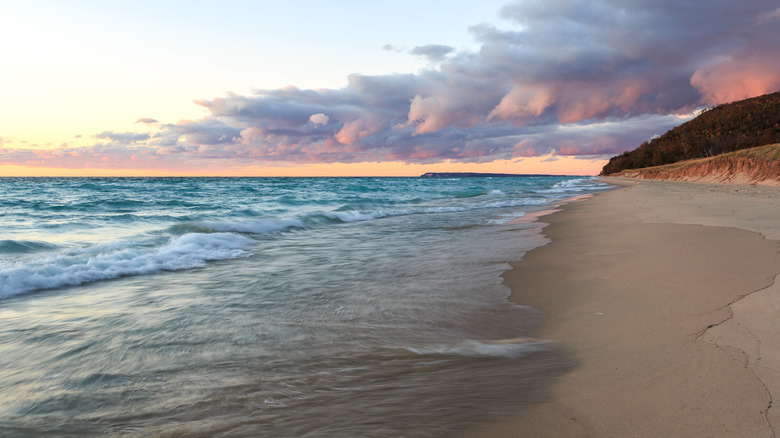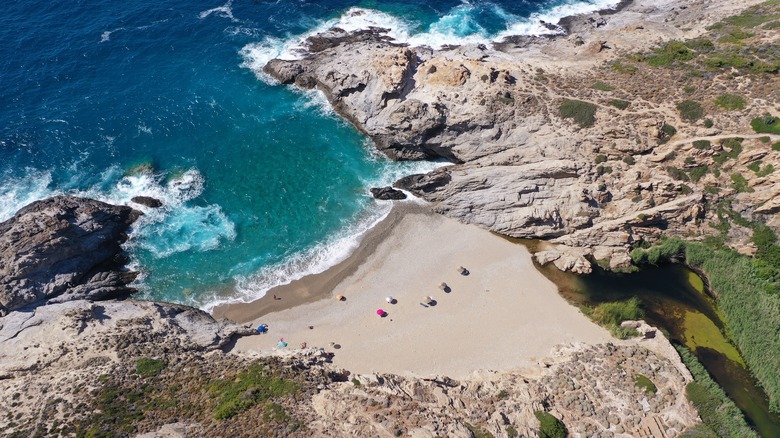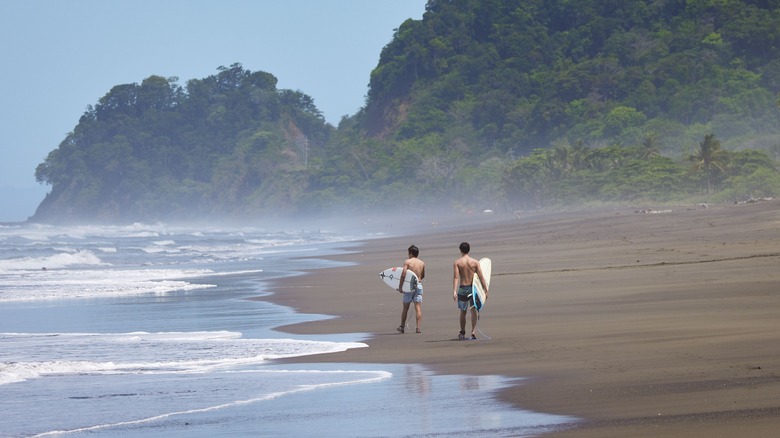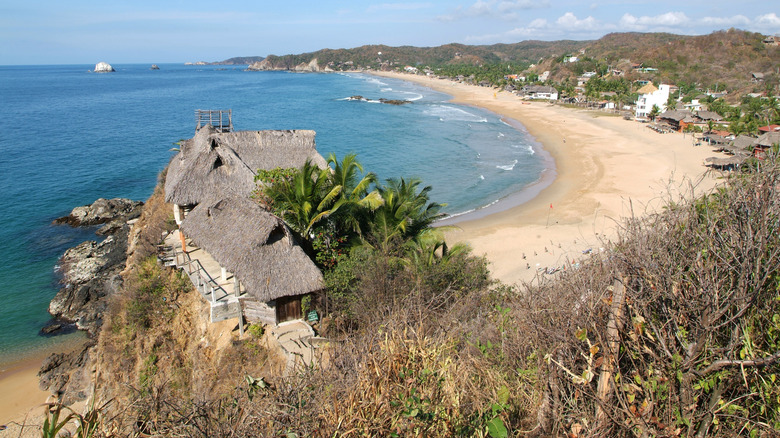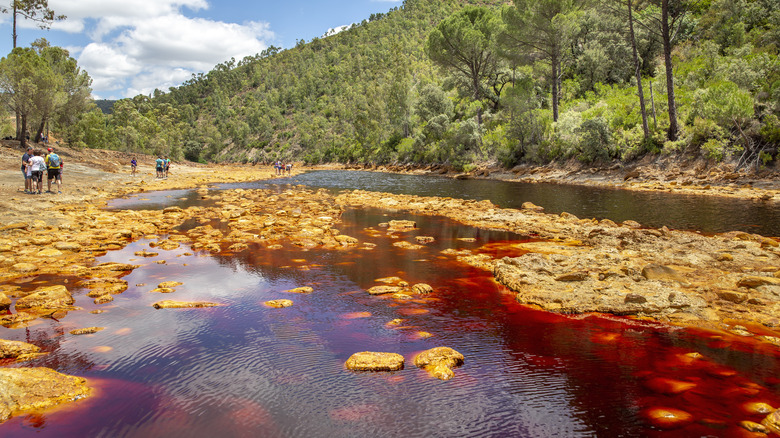The Most Dangerous Spots To Swim In The World
Swimming in a pool, especially a private plunge pool at a tropical resort, is a real treat. But it's no match for paddling around in open water, whether that be a river, a lake, or the sea. Splashing in a natural body of water is not only soothing and liberating, it's also therapeutic, shown to improve one's health, lift our mood, and reduce depression and anxiety. All around the world, places invite travelers to swim, to revel in the water for a cooling dip or extended float.
From unknown Caribbean vacation destinations to sensational island beaches in Japan, there are tons of spots all over the planet to splash, frolic, lounge, and plunge with abandon. However, some swimming locales may look inviting — with beautifully crafted slashes of nature that call out to travelers, especially seductive on a searing hot day — but pulse with hidden danger. From unseen currents to shocking pollution, the water in some locations should be avoided at all costs, even if you're desperate for an invigorating, refreshing dip.
Amazon River, South America
The list of superlatives of the defining waterway of South America makes for some eye-opening reading. It's the biggest river on the continent, has the most far-reaching drainage network on the planet, and is long enough that it would comfortably bridge the distance between London and the Pakistani city of Karachi. Some parts of the river are narrow enough to see the other bank, but other sections are broad enough that the Amazon appears like a sea.
The currents also vary, quickly turning from calm and languid to strong and savage. That, in itself, is reason enough to avoid a swim here, but another deterrent is the dangerous wildlife that lives within. The Amazon River, which winds through many countries in the continent, is a regional artery that supports wildlife like piranhas, caimans (similar to alligators), and electric eels. Adventurous travelers exploring the Amazon River could conceivably take a dip and emerge unscathed, but is it worth the gamble?
Cable Beach, Australia
The town of Broome, in the north of Australia, has long been a hub for the pearling industry. It's also the gateway to trips to the striking red-rock scenery of the remote Kimberley region, much of which is only accessible by boat. But Broome is also a vacation destination in its own right, where sunset camel rides on the town's most famous stretch of sand are a rite of passage. Cable Beach is a wide piece of waterfront that stretches for miles.
The swimming is wonderful, and for years, it was one of the few places in the country where people could sunbathe in the buff without anyone batting an eye. During the warmer months, however, from November through May (summer and fall in the Southern Hemisphere), the beach is beset by jellyfish. Not just any old jellyfish, but dangerous box varieties like the small Irukandji, whose sting can lead to intense pain and breathing problems for swimmers.
Juhu Beach, India
The pulsing economic center of the most populous nation in the world, Mumbai is a roiling metropolis of construction, traffic, and endless tides of people. It has some of the most addictive street food in India and cool hangout spots like the food center at Juhu Beach, which is close to the chic JW Marriott Mumbai Juhu.
For Mumbaikers, Juhu is a family-friendly escape from the freneticism of the city, a place to peer out at the sea, survey the coastline as it curls away to the left, and have a bite to eat while catching some sea air. But sadly, it's also an environmental blight. Every day, piles of garbage — some dropped by beachgoers, some washed up from the water — blanket the mud-colored sand. And if that wasn't off-putting enough, the water here teems with raw sewage, with the city regularly dumping untreated effluence into the sea.
Hot Water Beach, New Zealand
On the North Island's Coromandel Peninsula, Hot Water Beach is a fun place that has to be experienced to be believed. Thanks to the unique geothermal makeup of this part of New Zealand, heated spring water courses below the sand. When the tide is high, the warm section beach is covered by the sea, but two hours before and after low tide, that area reveals itself. During that compact window, beachgoers descend on the beach with spades in hand to dig small pits in the sand.
The pools fill with hot water — hence the name of the beach — creating a natural heated tub perfect for a restorative soak. Travelers can also walk along the sand that's nice and toasty during this time, but what they shouldn't do is go for a swim deep into the sea. The surf is strong, and the currents are extremely powerful, with strong rip currents (even in knee-deep water) that can easily yank a swimmer out to sea.
High Rocks, Oregon
On a hot summer day, the kind where the sun beats down with unrelenting fury, a cooling leap into a swimming hole can feel like you just escaped from jail. In Oregon, High Rocks is a swimming area in the Clackamas River, in the town of Gladstone, and easily accessible from Portland. It's a broad spot, named for the picturesque boulders and outcroppings on the riverbanks. Visually, the place is immensely appealing, but swimmers beware.
People have drowned here, including healthy young adults, unexpectedly due to several factors. The water is very cold, which might seem like a bonus on a hot day, but can come as a real shock to the system. The currents are swirling and strong, and can suddenly sweep a bather away. And those rocky formations, which are so attractive above water, also create hidden ledges below — these can be fatal for a cold, tired bather who can't fight the current and gets trapped in them.
Huntington Beach, California
Up and down the coast around Los Angeles, a number of beaches attract residents of Southern California. Everyone has their favorite, from Zuma Beach in Malibu where dolphins can be spotted offshore, to the steep cliffs at Torrey Pines that allow visitors to admire the Pacific from afar. Huntington State Beach is also an attractive bit of waterfront, spreading over 121 acres. It pulls in active types for its volleyball and basketball courts, the paved trail is popular with runners and bikers, and the beach and its cool ocean waters attract water sports enthusiasts.
But that water is often relentless and raging, with strong breaks that are a boon for surfers. Rips are also commonplace, with sandbars forming along the water to create unpredictable currents. According to figures from the United States Lifesaving Association, there were almost 4,000 rescues made on Huntington Beach in 2022, an average of more than 10 people per day. Don't be one of them.
Kelingking Beach, Indonesia
This beach on the island of Nusa Penida, near Bali, is the kind of place that gets tourism brochures flying off the proverbial racks. To call it stunning is an understatement — you'll see high, sharp, and eroded cliffs overlooking soft, crumbly sand by clear, azure water. The beach is most easily accessed by boat, though it can also be reached via a coastal hike, and there's one particular cave that helps to frame some stunning shots. Although the area is beautiful, there is a swimming ban in place. However, some tourists still take to the sea — and drown.
Deaths have been recorded as recently as 2023, with travelers misjudging the strength of the waves and the violent power of the undertow and the rip currents. The cliffs also make the water very precarious, with swimmers running the risk of the waves bashing them against the rocks. This is one place to look, but not leap.
Lake Michigan, United States
A grand body of water that touches four states — Wisconsin, Illinois, Indiana, and Michigan — Lake Michigan has long attracted water lovers. Whether it's for boating, fishing, swimming, water sports, or sunset viewing from its eastern shore, the lake is a wellspring of enjoyment. The Great Lakes might seem like large, placid bodies of water, but they are not. Crashing waves and potent currents, including rips, occur with frequency, which may be surprising given that the lakes aren't tidal.
The winds, rivers, and streams that feed the lake all create water turbulence, and these can produce channels under the surface that are strong but not visible from the shore. While these currents can affect all the lakes, the most dangerous, as borne out by statistics, is Lake Michigan. According to figures from the Great Lakes Surf Rescue Project, of the 81 drownings in the Great Lakes in 2023, 39 (almost half) were in Lake Michigan, with deaths occurring in all four states.
Nas Beach, Greece
The islands of Greece are a dream for vacationers in search of idyllic beaches. Scattered around the Aegean Sea, the isles are like jewels in an expanse of turquoise and deep blue, plots of land large and small with varying topography (some are volcanic, like Santorini). The island of Ikaria sits closer to Turkey than the Greek capital of Athens and is a destination with charming villages, rugged interiors, and sublime sandy shorelines. There are fabulous beaches all over the island, but Nas Beach might just best them all — a small cove tucked between headlands that cedes to stunning clear water.
Getting here requires trekking down a rocky hill, but the payoff is worth it. However, this north coast beach has a sea floor that suddenly plummets a little out from the shore. The waves create strong currents that, combined with the rocky edges, spell disaster for swimmers who can be dragged out quickly or smashed against the rocks.
Palomino Beach, Colombia
On the north coast of Colombia, Palomino Beach provides visitors with a long stretch of waterfront on the Caribbean Sea. The town isn't large but has become a vacation hotspot, with hotels, resorts, shopping, and places to eat and drink populating the small grid of streets. The beach remains the main attraction though, unfurling along the coast for more than one mile and lined with palm trees. It does, however, suffer from erosion, and at high tide, there is limited space to enjoy it.
The waves are powerful, as are the currents, making swimming treacherous at any time of the year. At the western edge, where the Palomino River empties into the sea, currents can also be unpredictable, even for locals. In late 2023, on Christmas Day, a revered Colombian indigenous leader drowned at the mouth of the river while trying to save some people swimming — a sad, sobering reminder of the unanticipated power of water.
Playa Hermosa, Costa Rica
One of a string of beaches along the coastline of Puntarenas, southwest of the Costa Rican capital of San Jose, Playa Hermosa has slowly built a reputation as a spot for great surfing. It's close to the town of Jaco, where a well-developed tourist infrastructure allows visitors to eat, drink, be merry, play beach volleyball, and dance the night away. Many, no doubt, are drawn by the surfing, with surf schools operating here, and a long beach — it stretches for miles along the Pacific Ocean — making entry points easy.
The beach is quiet, a stark contrast to the lively ambiance of Jaco, but it's also wildly natural, with repetitive and reliable waves forming powerful barrels. For swimmers, it's a definite no-no, with perilous currents and rip tides. Even beginner surfers should charge with caution. This is the domain of seasoned wave riders, but even they have been known to perish here. American surfer Kalani David died in the waves of Playa Hermosa in 2022 after having a seizure in the strong surf.
Playa Zipolite, Mexico
Due south of the town of Oaxaca, in the southern half of Mexico, this beach refuge is a great place to spend a few days and disconnect from the world. It's a fun place to visit, with great food — Oaxaca state is famous for its cuisine — and cool places to hang out. And the beach is generously proportioned and promises views both of the sunrise and sunset. But Playa Zipolite, which is book-ended by headlands, is known for its swirling currents that can send swimmers far out to sea or drag them in toward the shore with immense force.
And the currents are not easy to spot or predict. Sometimes bathers get caught in rip tides, which will spit them some distance from the beach, and the open water of the Pacific Ocean can be hard to navigate. Take our advice and hit the beach for a stroll or a sunset drink, then swim in your hotel pool.
Port St. Johns, South Africa
A town set on a rugged coastline of the Eastern Cape province, Port St. Johns appeals to visitors in search of some untamed nature. This part of the country has been named the Wild Coast, a place not besmirched by rampant development, where travelers come for craggy coastal bluffs and windswept beaches. Set back from the water, the dense forest is a realm for some secluded walks, but it is perhaps the beach that draws most visitors.
It also attracts whales and dolphins, which can be spotted on tours, as well as sharks, especially at Port St. Johns Second Beach. In the period between 2009 to 2014, eight people were killed by shark attacks on this beach. The last victim was a tourist from Austria who was standing in the shallows close to the sand. The Eastern Cape, according to the safety organization Shark Spotters, is where most unprovoked shark bites in South Africa occur, with white, bull, and tiger sharks all roaming the waters here.
Réunion, Indian Ocean
The Indian Ocean island is another paradise for fans of the great outdoors. The densely forested mountains and regions of the island are so stunning that about 40% of the island, where the landscape is dominated by volcanic structures and huge cliffs, is a UNESCO World Heritage Site. The scenery here is spectacular with a capital "S" — with gorges, peaks, plateaus, escarpments, plains, rainforests, and of course, silky seas. Hundreds of microclimates dot the island, and rich environments on the land and in the water are home to a range of plants and animals.
Among the residents of the ocean that circles Réunion are sharks, and some of them get fresh with swimmers. According to data from the Florida Museum's International Shark Attack File, there were 19 shark attacks in Réunion between 2012 and 2021, with eight of them deadly (in Hawaii, during the same period, there were three fatalities). Swimming is actually banned in many parts of the island for this very reason.
Río Tinto, Spain
In the south of Spain, not far from the town of Huelva, the name of this river hints at what visitors can expect. Literally translating to red, or stained, river, Río Tinto is indeed a waterway with a rusty tinge. For many miles, the river winds its way through an area where, hundreds of millions of years earlier, volcanoes were prevalent.
Deposits of sulfide ore accumulated, and now, those minerals, when exposed to water and air, turn the river water acidic and attract bacteria that give the water its distinct hue. Visitors shouldn't venture into the water, even for bragging rights, since it has a pH equivalent to that of vinegar — not fun. While it's certainly a remarkable sight to experience, and one that might have you scratching your head in disbelief, the river is toxic and can be dangerous to your health (it will also stain your clothes).
Sandy Beach Park, Hawaii
On an electric stretch of coastline east of Honolulu, Sandy Beach Park is a gorgeous slice of waterfront. A long, sandy ribbon, the beach sits close to Koko Crater, the Hanauma Bay Preserve, which is a top spot for snorkeling in Hawaii, and by the explosive Halona Blowhole. Rocky headlands sit at one end of Sandy Bay, and visitors can admire the waves crashing up against them. Take note of that force. It gives an idea of the energy of the ocean here: the kind of crushing power that can smite an unsuspecting swimmer.
The beach is a big draw for surfers, lured by the strong breaks, big barrels, and incessantly pounding surf. Heavy waves hammer the shore here, and they'll hammer you too if you get caught out, easily flipping you upside down or dragging you to the ocean floor. Little surprise, then, that this piece of Hawaii waterfront is known as Broke Neck Beach. There are also sections of reefs, with sharp, unforgiving corals that will slice open any exposed skin with the efficiency of a sous chef.
St. Mary's Bay, United Kingdom
The activist organization Surfers Against Sewage has been at the forefront of highlighting the filthy water around the coastline of the United Kingdom, producing an annual report on its quality. Many places have levels of pollution and bacteria that make swimming unsafe, and among them is St. Mary's Bay, on the south coast of England, a short distance from the famous White Cliffs of Dover.
St. Mary's Bay may not have direct sewage flowing into its long shoreline, but the shingle beach, which yields to deep sand flats at low tide, has terrible water quality with high levels of intestinal bacteria. Bathing here is not advisable. The U.K.'s Environment Agency categorized the water quality at St. Mary as poor in both 2022 and 2023. Even before that, the sea here wasn't ideal, with the prior two years showing it only received a rating of sufficient — hardly a resounding endorsement for a prospective swimmer.
Tamarama Beach, Australia
A compact stretch of sand near Bondi Beach — one of the most famous beaches in the world — Tamarama Beach is one of three Waverley beaches (along with Bondi and Bronte) that are easy to access from the center of Sydney. While it might not have the global cachet or the crowds of Bondi, it is a fine piece of waterfront and only a few hundred feet across. The beach also features bathrooms, barbecue facilities, and showers for rinsing off that sticky sand.
Some poke fun at Tamarama for the glamorous Sydneysiders that descend here on a warm summer day, but whatever the clientele, it's an undeniably alluring spot. At least it is for the beach. Swimming conditions here are another matter, and even with lifeguards on duty, bathers enter the water at their own peril. The surf is strong and merciless, and strong currents include rip tides. Unsurprisingly, people in the water will typically be experienced surfers.








